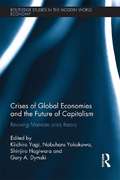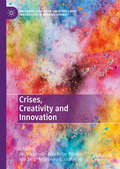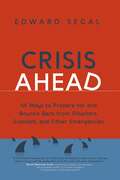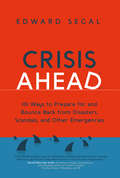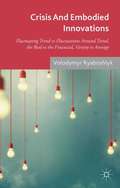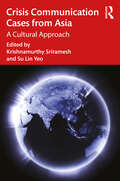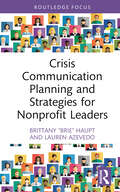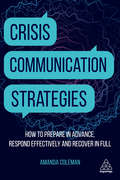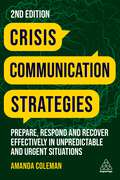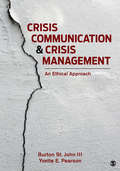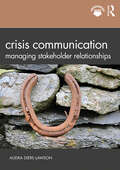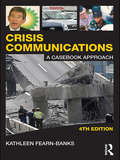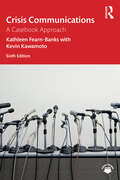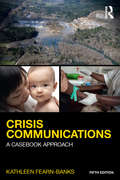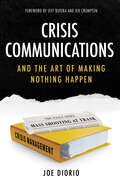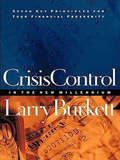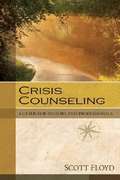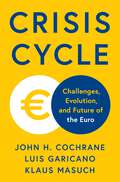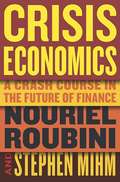- Table View
- List View
Crises of Global Economy and the Future of Capitalism: An Insight into the Marx's Crisis Theory (Routledge Studies In The Modern World Economy)
by Nobuharu Yokokawa Kiichiro Yagi Shinjiro Hagiwara Gary A. DymskiRecent events in the global financial markets and macro economies have served as a strong reminder for a need of a coherent theory of capitalist crisis and analysis. This book helps to fill the gap with well-grounded alternative articulations of the forces which move today's economic dynamics, how they interact and how ideas of foundational figures in economic theory can be used to make sense of the current predicament. The book presents a comprehensive collection of reflections on the origins, dynamics and implications of the interlinked crises of the U.S. and global economies. The book is a thoughtful collaboration between Japanese heterodox economists of the Japan Society of Political Economy (JSPE) and non-Japanese scholars. It provides a unique immersion in different, sophisticated approaches to political economy and to the crisis. The book illustrates with the understanding of Marx's crisis theory and how it can serve as a powerful framework for analyzing the contemporary sub-prime world crisis. The book explains the subprime loan crisis as a crisis in a specific phase of the capitalist world system and concludes that it is a structural one which destroys the existing capital accumulation regime. It pays attention to structural changes and to how these changes beget profound and controversial consequences. The result is a must-read - one which truly contributes to the resurgence of radical analyses of the political economy, free from the market optimism of the main-stream economics.
Crises, Creativity and Innovation (Palgrave Studies in Creativity and Innovation in Organizations)
by Roni Reiter-Palmon Min Tang Zorana Ivcevic Magdalena G. GrohmanThis book aims to provide a better understanding of the different practices of creativity and innovation under crisis situations. Drawing on theories and studies by scholars in psychology, education, and organizational behavior, this edited collection brings together renowned international experts to explore the active and reactive adaptations to the transformations caused by crises. It discusses how abrupt changes in personal, social, political, economic, or environmental affairs are an integral part of our individual and social lives, which drive people and organizations to adapt and change. With flexibility, adaptability, and problem-solving at the core of its nature, creativity and innovation have the potential to help people cope with harsh and uncertain circumstances caused by crises. This book delves into the positive relationship between the experience of crisis and creativity and innovation, presenting theoretical inquiries, empirical studies, and their practical implications for a constructive shift in crisis management, coping mechanisms, and individual and societal wellbeing. A must read for researchers in psychology, philosophy, sociology, economy and politics, interested in crisis and disaster studies.
Crisis Ahead: 101 Ways to Prepare for and Bounce Back From Disasters, Scandals, and Other Emergencies
by Edward SegalHow many splashy scandals and crisis situations have befallen companies and public figures in the past week alone? How did the organizations and people at the center of those crises manage the situation? Did they survive with their reputations intact or are they facing an ongoing public nightmare that keeps building on itself in the era of social media?This new book from veteran public relations expert Edward Segal is based on the following premise: it's not a matter of IF a scandal or crisis will hit, it's WHEN. How a company deals with it will have lasting impact on their reputation, profits, and more. But for most organizations, when a crisis hits, they're caught off guard and ill-prepared. While essential, crisis plans are worthless unless properly executed, as the stories and examples featured throughout Crisis Ahead attest. Edward Segal's vivid and memorable accounts underscore the benefits of practicing and updating crisis plans at least once a year. The book also provides a template for creating a customizable crisis management plan.Crisis Ahead is for CEOs, senior staff, corporate communication professionals, HR and legal teams, boards of directors, and front-line employees who need to know what to do in the moment: what levers to pull and what moves to make in real time when faced with a crisis, scandal, or disaster. This book is written with the need for speed in mind. It's concise and practical with a light touch and occasional humor to help people on the front lines prepare for, survive, and bounce back from a crisis. It includes dozens of anecdotes, stories, and lessons about how companies, organizations, and individuals - ranging from Amazon, Apple, and the European Union, to Disney, Starbucks, and entrepreneur Elon Musk - have prepared for, created, managed, and communicated about crisis situations.
Crisis Ahead: 101 Ways to Prepare for and Bounce Back from Disasters, Scandals and Other Emergencies
by Edward SegalHow many splashy scandals and crisis situations have befallen companies and public figures in the past week alone? How did the organizations and people at the center of those crises manage the situation? Did they survive with their reputations intact or are they facing an ongoing public nightmare that keeps building on itself in the era of social media?This new book from veteran public relations expert Edward Segal is based on the following premise: it's not a matter of IF a scandal or crisis will hit, it's WHEN. How a company deals with it will have lasting impact on their reputation, profits, and more. But for most organizations, when a crisis hits, they're caught off guard and ill-prepared. While essential, crisis plans are worthless unless properly executed, as the stories and examples featured throughout Crisis Ahead attest. Edward Segal's vivid and memorable accounts underscore the benefits of practicing and updating crisis plans at least once a year. The book also provides a template for creating a customizable crisis management plan.Crisis Ahead is for CEOs, senior staff, corporate communication professionals, HR and legal teams, boards of directors, and front-line employees who need to know what to do in the moment: what levers to pull and what moves to make in real time when faced with a crisis, scandal, or disaster. This book is written with the need for speed in mind. It's concise and practical with a light touch and occasional humor to help people on the front lines prepare for, survive, and bounce back from a crisis. It includes dozens of anecdotes, stories, and lessons about how companies, organizations, and individuals - ranging from Amazon, Apple, and the European Union, to Disney, Starbucks, and entrepreneur Elon Musk - have prepared for, created, managed, and communicated about crisis situations. p.p1 {margin: 0.0px 0.0px 0.0px 0.0px; font: 12.0px 'Helvetica Neue'; color: #454545}
Crisis And Embodied Innovations
by Volodymyr RyaboshlykThis book introduces embodied innovations into the circle of already recognised causes of economic crises. The author shows how issues of investment, accumulation and structural change associated with embodied innovations can be used to monitor potential crisis. The author argues that crises are predictable and manageable in depth.
Crisis Communication Cases from Asia: A Cultural Approach
by Krishnamurthy Sriramesh Su Lin YeoThis book analyzes crisis communication in Asia, focusing on how culture (broadly defined) plays a central role in the way a crisis develops and is resolved.Using the case study method, this book offers the reader glimpses of the variety of cultures in the continent, displaying the complexity of the cross-cultural process of conducting crisis communication in this diverse environment. Each of these cases addresses the onset, evolution, and resolution of the crisis. The contributors are seasoned practitioners who have done crisis communication work in this continent and have used the same framework of five environmental variables that define culture in this book: political culture, economic systems, societal culture, media systems, and activist environments.This edited volume is ideal for scholars and advanced students in public relations and strategic communication generally and crisis communication specifically.
Crisis Communication Planning and Strategies for Nonprofit Leaders
by Brittany “Brie” Haupt Lauren AzevedoCrisis Communication Planning and Strategies for Nonprofit Leaders examines the unique position of nonprofit organizations in an intersection of providing public services and also being a part of Emergency and crisis management practices. This text discusses the evolution of crisis communication planning, the unique position of nonprofit organizations and the crises they face, along with provision of conceptual and theoretical frameworks to generate effective crisis communication plans for nonprofit organizations to utilize within diverse crises. Through the use of innovative real-life case studies investigating the impact of crisis communication plans, this book provides the foundational knowledge of crisis communication planning, theoretically supported strategies, crisis typology and planning resources. Each chapter focuses on critical strategic planning concepts and includes a summary of key points, discussion questions and additional resources for each concept. With this text, nonprofit organizations will be able to strategically plan for organization-specific and emergency management related crises, develop effective crisis communication plans, garner internal and external support and generate assessment strategies to maintain the relevancy of these plans within their future endeavors. Crisis Communication Planning and Strategies for Nonprofit Leaders offers a new and insightful approach to crisis communication planning to assist nonprofit organizations that are called upon to fulfill a variety of community needs, such as sheltering, food distribution, relief funding, family reunification services, volunteer mobilization and much more. It is an essential resource for nonprofit organizations.
Crisis Communication Strategies: How to Prepare in Advance, Respond Effectively and Recover in Full
by Amanda ColemanCrisis communication is high stakes work. For communications managers and PR professionals, it's likely to be the most stressful time of their working life. Crisis Communication Strategies is a must-have handbook for laying the groundwork before a crisis hits, meaning that when the inevitable day comes, the company already has policies and procedures in place to leap into meaningful action without delay. Crisis Communication Strategies is unique in the way it equips readers to deal with any kind of crisis - whether caused by internal error, customer action, natural disasters, terrorism or political upheaval. Moving chronologically, the book opens by looking at the skills, policies and procedures that should be set up in advance, during times of normal business operations. It then moves on to look at how those procedures can be activated when a crisis occurs and during the immediate response. Finally, it delivers strategies for true long-term recovery for both the company itself and, where necessary, the wider community. Packed with actionable tips, checklists and global case studies, Crisis Communication Strategies is the essential guide to protecting your company and building true, long-term resilience.
Crisis Communication Strategies: Prepare, Respond and Recover Effectively in Unpredictable and Urgent Situations
by Amanda ColemanIs your company equipped to deal with any kind of crisis - whether caused by internal error, customer action or social media mishap? This bestselling guide gives readers the skills, tools and knowledge to respond effectively to high-stake situations and protect your brand from disaster.Crisis Communication Strategies is a must-have guide that covers the whole span of a crisis from preparing and laying the groundwork before it occurs, during the incident and the aftermath, including the move to recovery and beyond. It guides readers through each phase, providing details of what to consider, what should be done, tips and checklists for improved responses.This second edition of Crisis Communication Strategies provides new sections on managing long-running crises. It also contains new content looking at the phases of crises, behavioural communication as a tactic and how to ensure diversity and inclusivity in tumultuous times.Supported by brand new case studies and examples from responses to events including the British Post Office scandal, Burger King's misfired International Women's Day campaign, Yorkshire cricket's racism scandal and Peloton's crises, it also explores the role of leadership in developing a crisis communication response that has people at its heart. This is an essential guide for PR and communications professionals who wish to protect their company and build long-term resilience.
Crisis Communication and Crisis Management: An Ethical Approach
by Yvette E. Pearson Burton St. JohnCrisis Communication and Crisis Management: An Ethical Approach is the only text on the market to provide students with the integration of ethical inquiry into the fundamentals of crisis communication.. Authors Burton St. John III and Yvette E. Pearson combine comprehensive coverage of the key skills, concepts, and theories of crisis communication with an extensive collection of contemporary case studies, giving students a strong understanding of the essential role that communicators play in moments of crisis. Students are encouraged to build upon their communication and ethical decision making skills using a variety of stakeholder inventories, hypothetical scenarios, discussion questions, and professional profiles. Students will also gain exposure to a mixture of discrete and ongoing crises, preparing them to manage both one-time crises and continuing crises.
Crisis Communication and Crisis Management: An Ethical Approach
by Yvette E. Pearson Burton St. JohnCrisis Communication and Crisis Management: An Ethical Approach is the only text on the market to provide students with the integration of ethical inquiry into the fundamentals of crisis communication.. Authors Burton St. John III and Yvette E. Pearson combine comprehensive coverage of the key skills, concepts, and theories of crisis communication with an extensive collection of contemporary case studies, giving students a strong understanding of the essential role that communicators play in moments of crisis. Students are encouraged to build upon their communication and ethical decision making skills using a variety of stakeholder inventories, hypothetical scenarios, discussion questions, and professional profiles. Students will also gain exposure to a mixture of discrete and ongoing crises, preparing them to manage both one-time crises and continuing crises.
Crisis Communication in Canada
by Duncan KoerberPrivate companies that respond poorly to a crisis may go bankrupt, wiping out investments and jobs. Charities that respond poorly to a crisis may lose donations, ending support for the most vulnerable. Professional athletes, religious leaders, CEOs, and politicians who respond poorly to a crisis may lose their long-standing careers and the respect of their colleagues, supporters, fans, and customers. This book offers both theory and practical help for organizations and professionals to deal effectively with crises. Crisis communication lessons have typically been the purview of public relations professionals. However, since the 1990s there has been a growing body of scholarly research on the topic. Crisis Communication in Canada offers a unique scholarly and professional contribution, synthesizing recent research and providing a context for practical advice. Written in clear and concise style, directed at beginners but rooted in research, this book will offer instructors and students a unique resource for the study and practice of crisis communication.
Crisis Communication: A Stakeholder Approach
by Martin N. NdlelaThis timely book explores crises as an inevitable part of modern society, which causes ramifications not only for organisations, but also for a diverse range of stakeholders. Addressing the need for organisations to be guided by a stakeholder-oriented approach throughout all phases of the crisis communication process, the author draws upon various business disciplines and covers the management of issues, risk, reputation and relationships. Covering all stages of crisis communication, from pre-crisis to post-crisis, stakeholder engagement is analysed through a series of case studies, with a particular focus on the role of social media. Scholars of corporate communications and business strategy will find this new book undoubtedly useful, and it will be of particular interest to those involved in crisis communication and management.
Crisis Communication: Managing Stakeholder Relationships
by Audra Diers-LawsonCrises come in many shapes and sizes, including media blunders, social media activism, extortion, product tampering, security issues, natural disasters, accidents, and negligence – just to name a few. For organizations, crises are pervasive, challenging, and catastrophic, as well as opportunities for organizations to thrive and emerge stronger. Despite the proliferation of research and books related to crisis communication, the voice that is often lost is that of the stakeholder. Yet, as both a public relations and management function, stakeholders are central to the success and failure of organizations responding to and managing crises in a cross-platform and global environment. This core textbook provides a comprehensive and research-driven introduction to crisis communication, critical factors influencing crisis response, and what we know about predicting stakeholder responses to crises. Incorporated into each chapter are global case studies, ethical challenges, and practitioner considerations. Online resources include an extensive set of multimedia materials ranging from podcast mini-lectures to in-class exercises, and simulation-based activities for skills development (https://audralawson.com/resources/crisis-communication-managing-stakeholder-relationships/). Demonstrating the connection between theory, decision-making, and strategy development in a crisis context, this is a vital text for advanced undergraduate and postgraduate students of Communications, Public Relations, Marketing, and Strategic Management.
Crisis Communication: Theory and Practice
by Alan Jay ZarembaCrises happen. When they do, organizations must learn to effectively communicate with their internal and external stakeholders, as well as the public, in order to salvage their reputation and achieve long-term positive effects. Ineffective communication during times of crisis can indelibly stain an organization’s reputation in the eyes of both the public and the members of the organization. The subject of crisis communication has evolved from a public relations paradigm of reactive image control to an examination of both internal and external communication, which requires proactive as well as reactive planning. There are many challenges in this text, for crisis communication involves more than case analysis; students must examine theories and then apply these principles. This text prepares students by: Providing a theoretical framework for understanding crisis communication Examining the recommendations of academics and practitioners Reviewing cases that required efficient communication during crises Describing the steps and stages for crisis communication planning Crisis Communication is a highly readable blend of theory and practice that provides students with a solid foundation for effective crisis communication.
Crisis Communications
by Kathleen Fearn-BanksCrisis Communications: A Casebook Approach presents case studies of organizational, corporate, and individual crises, and analyzes the communication responses to these situations. Demonstrating how professionals prepare for and respond to crises, as well as how they develop communications plans, this essential text explores crucial issues concerning communication with the news media, employees, and consumers in times of crisis. Author Kathleen Fearn-Banks examines the steps of choosing the appropriate words to convey a message, selecting the method and channels for delivering the message, and identifying and targeting the most appropriate publics or audiences. She also addresses such important topics as avoiding potential mismanagement of communication in crisis situations. Key features of this fourth edition are: six new cases, including several international crises current discussion of communications technology as it relates to crises a Companion Website -- www.routledge.com/textbooks/fearn-banks -- with additional cases as well as supplemental materials for students and classroom resources for instructors. A Student Workbook is also available for use with this volume, providing additional pedagogy for each chapter, including discussion questions, activities, key terms, case exercises, and worksheets. Utilizing both classic and contemporary cases of real-world situations, Crisis Communications provides students in public relations and business with real-world perspectives and valuable insights for professional responses to crises. It is intended for use in crisis communications, crisis management, and PR case studies courses.
Crisis Communications: A Casebook Approach (ISSN)
by Kathleen Fearn-Banks Kevin KawamotoNow in its sixth edition, this book provides engaging, practice-oriented case studies analyzing communication professionals’ crisis preparation and responses, illustrating key considerations for communicating with both internal and external stakeholders during and after a crisis.This edition continues its strength as a student-friendly text that demonstrates how to craft, target, and deliver messages during crises in order to mitigate further controversy and distress. Classic cases lay the foundation, while contemporary cases shed light on cutting-edge practices in use today. Many cases from previous editions have been updated and new cases added, including the COVID-19 crisis and U.S. vaccination campaign; Starbucks and racial discrimination at a Philadelphia branch; Will Smith and the Academiy Awards slap; Gander, Newfoundland in supporting stranded tourists after the attacks of September 11, 2001; and a look at how schools can prepare communication responses to school shootings. Each case pays particular attention to the actual and ideal use of social media in the crisis and there is a new section on the important issues of misinformation and disinformation.Crisis Communications, 6th Edition is intended for courses in crisis communication, crisis management, disaster response, corporate communications, and public relations.Student and instructor online support materials feature selected previous editions’ case studies no longer in this edition as well as an Instructor’s Manual with suggested activities, discussion questions, and sample quizzes: www.routledge.com/9780367894450.
Crisis Communications: A Casebook Approach (Routledge Communication Series)
by Kathleen Fearn-BanksCrisis Communications: A Casebook Approach presents case studies of organizational, corporate, and individual crises, and analyzes the communication responses to these situations. Demonstrating how professionals prepare for and respond to crises, as well as how they develop communications plans, this essential text explores crucial issues concerning communication with the news media, employees, and consumers in times of crisis. Author Kathleen Fearn-Banks addresses how to choose the best possible words to convey a message, the best method for delivering the message, and the precise and most appropriate audience, in addition to illustrating how to avoid potential mismanagement. The fifth edition of Crisis Communications includes updated cases that provide wider coverage of international crises and media technologies. It includes a new section on social media in crisis communication scenarios and includes additional comments from social media experts throughout various chapters. New case studies include "Police Departments and Community Trust," "The Oso Mudslide in Washington," "School Shootings: Communications To and For Children," and two additional international case studies - "Ebola Strikes Liberia: Firestone Strikes Ebola" and "Nut Rage and Korean Airlines." Previous case studies no longer in this edition can be found on the book’s companion website, which also includes the Instructor’s Manual with exercises in crisis responses, guidelines for crisis manual preparation, and other teaching tools: www.routledge.com/cw/fearn-banks. Looking at both classic and modern cases in real-world situations, Crisis Communications provides students with real-world perspectives and insights for professional responses to crises. It is intended for use in crisis communications, crisis management, and PR case studies courses. Also available for use with this text is the Student Workbook to Accompany Crisis Communications, providing additional discussion questions, activities, key terms, case exercises, and further content for each chapter.
Crisis Communications: and the Art of Making Nothing Happen
by Joseph J. DiorioCrises happen. But how they are handled makes all the difference in the world.It's 2019. A gunman enters Trask International, a suburban Washington, D.C. office, leaving three people dead and dozens injured. One of the biggest differences between this tragedy and \the many others that have unfortunately occurred recently? They were ready for this. Trask International had a comprehensive Crisis Communications plan.No, the plan didn't deploy bulletproof shields, nor did it call upon a secret superhero to fight off the gunman. But the plan did spell out how the business should respond in public to what happened, keep the focus on the true victims and not position the business as one, and how the business could—and would—get things back to normal as quickly as possible.Crisis Communications and the Art of Making Nothing Happen is a fast-paced story told in two parts—the first tells the tale of the shooting itself, while the second presents a deep dive into how a business prepares for a crisis. It takes a close look at the teamwork involved with crisis communication planning, and, ultimately, how preparation helps keep a bad situation from getting worse.
Crisis Control For 2000 and Beyond: Boom or Bust?
by Larry BurkettBest-selling author, Larry Burkett, looks at Y2K and the growing world-wide economic instability and gives his evaluation. Will it be a boom or a bust economy? Either way, the seven basic principles he shares will provide God's wisdom to investors of all ages and incomes.
Crisis Counseling: A Guide for Pastors and Professionals
by Scott FloydDr. Floyd helps readers understand the nature of crises events, how individuals are impacted, and how to best provide help during and following times of trauma, loss, and grief.
Crisis Cycle: Challenges, Evolution, and Future of the Euro
by John H. Cochrane Klaus Masuch Luis GaricanoHow the euro survived a series of crises, and how to make it more resilientThe euro has survived crises unimagined at its founding: the financial meltdown of 2007–2009, the sovereign debt crisis of 2010–2012, the pandemic, and the Russian invasion of Ukraine. The European Central Bank fought these crises with dramatic policy innovations, buying up vast amounts of debt and providing large loans to banks. But now everyone expects the ECB to intervene routinely, and the euro is more fragile as a result. Crisis Cycle recounts this history and offers recommendations for restoring a durable monetary union.Monetary and fiscal policy are intertwined, especially in a currency union like the eurozone. Member states can be tempted to borrow and spend too much, and then count on the ECB to rescue them by printing money to buy their bonds. To avoid these disincentives, the ECB was founded with a narrow mandate: use interest rates to pursue price stability, and don&’t buy sovereign debt. Debt and deficit rules would keep countries from getting into trouble.The ECB&’s emergency innovations brought back these disincentives. How can the EU avoid larger and larger bailouts? The authors argue that Europe needs a joint fiscal institution that can provide temporary help to sovereigns, a resolution mechanism so sovereign default is a motivating possibility, and bank reform that ensures sovereign default will not bring down the financial system. This timely book shows how to restore the euro&’s ambitious and effective founding framework. The unique group of authors combine extensive policy experience and authoritative academic credentials.
Crisis Economics: A Crash Course in the Future of Finance
by stephen Roubini Nouriel MihmOne man saw it coming. As far back as 2005, Professor Nouriel Roubini – aka 'Dr Doom' – warned that the US housing bubble was set to crash, and what would begin as a national disease would soon spread overseas resulting in a deep recession. Free market fundamentalism would fail and we'd be faced with the worst economic crisis in history, crippling our global economy and bringing the world's financial systems to a shuddering halt. Sound familiar? By guiding us through a crash course in 'crisis economics' – black swans and white swans, pressure points in the global economy, crises that extend beyond national borders and bubbles in the financial sector that spill over into the real economy – Roubini shows us that boom to bust economics does not have to be destiny. Roubini offers a course for the future: radical reform of the international financial order and a clear view of regulation, supervision and greater coordination between central banks in Europe, Asia and the United States.
Crisis Economics: A Crash Course in the Future of Finance
by Stephen Mihm Nouriel RoubiniThis myth-shattering book reveals the methods Roubini used to foretell the current crisis before other economists saw it coming and shows how those methods can help to make sense of the present and prepare for the future.
Crisis Era European Integration: Economic, Political and Social Lessons from Croatia (Routledge Studies in the European Economy)
by Jakša Puljiz Hrvoje ButkovićThe year 2023 marked the tenth anniversary of Croatia’s membership of the European Union, the last acceding country to the EU, and thus represents a fitting opportunity to explore the political, economic and social dimensions of this tremendous transformation. This book examines how Croatia has changed over the last ten years and looks at the driving forces as well as the obstacles on its post-accession path of Europeanisation.The book argues that the Croatian case has special importance given that the last decade of European integration has arguably been the most challenging one yet. It started with the Eurozone-wide sovereign debt crisis and ended with the economic hardship caused by the COVID-19 pandemic and Russia’s aggression on Ukraine. Such demanding circumstances where agenda was often defined in an ad hoc way posed a huge test for Croatia’s governmental capacity. The book provides answers to the question of how successful Croatian policymakers were in dealing with the crises-related challanges and other needed adaptations. The book explores how EU membership has affected the design and implementation of selected national public policies, the functioning of governing institutions and patterns of cooperation between main social actors. Expert contributors analyse the impact of the EU membership in two principal areas: political and economic, with individual chapters addressing relevant topics.The book is intended for researchers, academics and students interested in these issues, as well as policymakers, entrepreneurs and lobbyists concerned with European integration.
